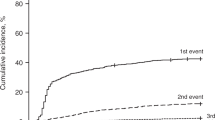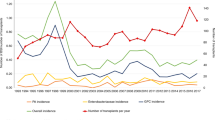Abstract
We reviewed the results of routine microbiological assays of 3078 infused hematopoietic progenitor cell (HPC) products for autologous and allogeneic transplantation between January 2001 and December 2005. Thirty-seven (1.2%) contaminated products were found. All patients receiving contaminated infusions received empirical antibiotic prophylaxis according to the assay result. None of these patients developed a positive blood culture with the same agent, developed infections that could be attributable to the contaminated product or experienced any clinical sequelae. Coagulase-negative Staphylococcus was found in 32 (86.5%) products. Admission lengths and time to engraftment were within the expected time frame for autologous and allogeneic transplants. Microbial contamination of HPC products occurs at a low frequency; prophylactic use of antibiotics based on the microbiological assay appears to be effective in preventing clinical complications.
This is a preview of subscription content, access via your institution
Access options
Subscribe to this journal
Receive 12 print issues and online access
$259.00 per year
only $21.58 per issue
Buy this article
- Purchase on Springer Link
- Instant access to full article PDF
Prices may be subject to local taxes which are calculated during checkout
Similar content being viewed by others
References
Lowder JN, Whelton P . Microbial contamination of cellular products for hematolymphoid transplantation therapy: assessment of the problem and strategies to minimize the clinical impact. Cytotherapy 2003; 5: 377–390.
Ritter M, Schwedler J, Beyer J, Movassaghi K, Mutters R, Neubauer A et al. Bacterial contamination of ex vivo processed PBPC products under clean room conditions. Transfusion 2003; 43: 1587–1595.
Padley DJ, Greiner CW, Heddlesten-Rediske TL, Hopkins MK, Maas ML, Gastineau DA . Endogenous microbial contamination of cultured autologous preparations in trials of cancer immunotherapy. Cytotherapy 2003; 5: 147–152.
Cassens U, Ahlke C, Garritsen H, Krakowitzky P, Wullenweber J, Fischer RJ et al. Processing of peripheral blood progenitor cell components in improved clean areas does not reduce the rate of microbial contamination. Transfusion 2002; 42: 10–17.
Hirji Z, Saragosa R, Dedier H, Crump M, Franke N, Burrows L et al. Contamination of bone marrow products with an Actinomycete resembling Microbacterium species and reinfusion into autologous stem cell and bone marrow transplant recipients. Clin Infect Dis 2003; 36: 115–121.
Mele L, Dallavalle FM, Verri MG, Balza G, Allione B, Salvi F et al. Safety control of peripheral blood progenitor cell processing – eight year survey of microbiological contamination and bag ruptures in a single institution. Transf Aph Sci 2005; 33: 269–274.
Larrea L, de la Rubia J, Soler MA, Ribas P, Fernandez JM, Picon I et al. Quality control of bacterial contamination in autologous peripheral blood stem cells for transplantation. Haematologica 2004; 89: 1232–1237.
Schwella N, Rick O, Heuft HG, Miksits K, Zimmermmann R, Zingsem J et al. Bacterial contamination of autologous bone marrow: reinfusion of culture-positive grafts does not result in clinical sequelae during the posttransplantion course. Vox Sang 1998; 74: 88–94.
Kamble R, Pant S, Selby GB, Kharfan-Dabaja MA, Sethi S, Kratochvil K et al. Microbial contamination of hematopoietic progenitor cell grafts – incidence, clinical outcome, and cost-effectiveness: an analysis of 735 grafts. Transfusion 2005; 45: 874–878.
Nasser RM, Hajjar I, Sandhaus LM, Hall GS, Avery RK, Bolwell BJ et al. Routine cultures of bone marrow and peripheral stem cell harvests: clinical impact, cost analysis, and review. Clin Infect Dis 1998; 27: 886–888.
Jestice HK, Farrington M, Hunt C, Matthews I, Scott MA, Foreman J et al. Bacterial contamination of peripheral blood progenitor cells for transplantation. Transf Med 1996; 6: 103–110.
Food and Drug Administration. Current good tissue practice for human cell, tissue, and cellular and tissue-based product establishments; inspection and enforcement; final rule (November 18, 2004). Fed Regist 2004; 69: 68612–68688.
Webb IJ, Andersen JW, Elias AD, Finberg RW, Nadler LM, Ritz J et al. Sources and sequeale of bacterial contamination of hematopoietic stem cell components: implications for the safety of hematotherapy and graft engineering. Transfusion 1996; 36: 782–788.
Prince HM, Page SR, Keating A, Saragosa RF, Vukovic NM, Imrie KR et al. Microbial contamination of harvested bone marrow and peripheral blood. Bone Marrow Transplant 1995; 15: 87–91.
Author information
Authors and Affiliations
Corresponding author
Rights and permissions
About this article
Cite this article
Patah, P., Parmar, S., McMannis, J. et al. Microbial contamination of hematopoietic progenitor cell products: clinical outcome. Bone Marrow Transplant 40, 365–368 (2007). https://doi.org/10.1038/sj.bmt.1705731
Received:
Revised:
Accepted:
Published:
Issue Date:
DOI: https://doi.org/10.1038/sj.bmt.1705731
Keywords
This article is cited by
-
Isolation of Anaerobic Bacteria During Quality Analysis of Medicinal Products
Pharmaceutical Chemistry Journal (2018)
-
Quality monitoring of microbial contamination of cryopreserved parathyroid tissue
Cell and Tissue Banking (2011)
-
Immune Deficits in Allogeneic Hematopoietic Stem Cell Transplant (HSCT) Recipients
Mycopathologia (2009)



